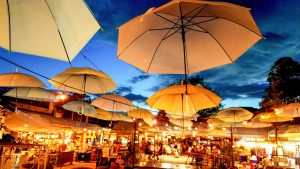Thailand has welcomed its first foreign tourists since normal travelers were banned from entering the country due to COVID-19 almost seven months ago. On October 20, 39 visitors arrived at Bangkok’s Suvarnabhumi Airport on a flight from Shanghai, under a special visa designed to stir the revival of the country’s moribund tourist sector.
Yuthasak Supasorn, the head of the Tourism Authority of Thailand, told local media that another 100 tourists from Guangzhou are also due to arrive on October 26, ahead of 400 more foreign visitors early next month.
The 39 Chinese nationals are the first foreigners to take advantage of a Special Tourist Visa (STV) program devised by Thai authorities to help restart the country’s tourist industry, which welcomed almost 40 million foreign visitors in 2019 and by some estimates accounts for more than a tenth of the country’s GDP.
As in other Southeast Asian countries, COVID-19 quickly brought Thailand’s tourist industry to a grinding halt. As regular travelers were barred from entering the country, the golden beaches of Phuket and the street markets of Chiang Mai emptied out, and the livelihoods of tens of thousands of tourist operators were thrown into chaos.
Under the STV program, which was approved by the Thai cabinet last month, tourists from “low-risk” countries are now permitted to enter Thailand for long stays of up to 270 days. There is a long list of conditions. After arriving, the visitors must stay in government-approved quarantine at a hotel or hospital for 14 days. They are required to undergo pre-departure testing for the virus and take out special COVID-19 coverage issued by Thai insurers. They also need to prove that they have at least half a million baht ($16,000) in savings.
Currently, foreigners are allowed into Thailand for medical reasons, or if they have a visa to study or work in the country, while general tourists are still barred from coming.
China is in many ways a logical place for the Thai tourism authorities to start. As outbound Chinese tourism has boomed, Thailand has grown into one of the most popular overseas destinations for Chinese tourists. In 2019, nearly 11 million Chinese nationals visited Thailand, out of a total of 39.8 million foreign tourist arrivals.
In January, Thailand became the first country outside of China to detect a COVID-19 infection, reportedly contracted from a Chinese tourist from Wuhan. But now that China has mostly successfully contained the virus domestically, it looms as a natural partner in the revival of the industry. Indeed, the Thai government is reportedly in talks with China to exempt Chinese tourists from the required 14-day quarantine by 2021 – something that reportedly hinges on the success of the STV program.
The STVs will be offered until September 2021, and Thai authorities expect them to attract 1,200 travelers per month – mostly well-heeled visitors from China and northern Europe eager to escape the winter months. But the stringent requirements mean that just a tiny fraction of pre-COVID-19 tourist arrivals. In fact, many of the Chinese nationals applying for the STVs are reportedly long-term residents of Thailand who own property or run businesses in the country.
Nonetheless, the policy also hints at the centrality of China to Thailand’s – and Southeast Asia’s – recovery from the pandemic-induced economic recession. As much as Thai people might once have grumbled about the supposedly rude behavior of Chinese tour groups, they are now set to play an important part in getting Thailand’s tourist industry back up and running.

































